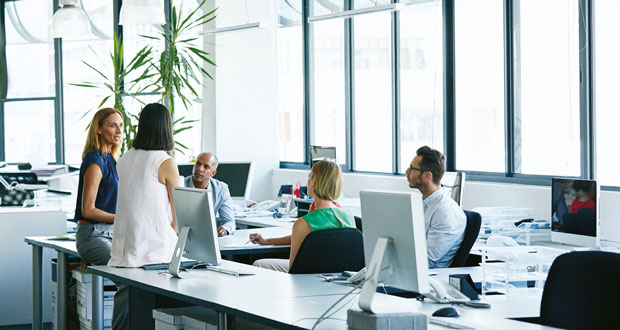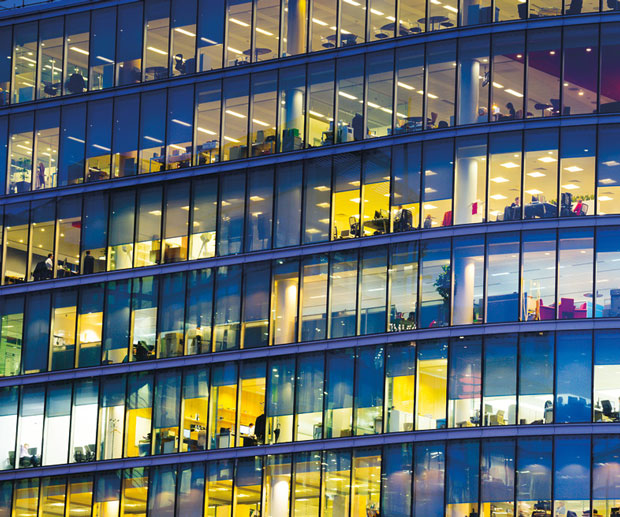 With over 35 years of innovation and research into the workplace Despina Katsikakis, Global Head of Workplace, Cushman & Wakefield believes now is the time for FMs to play a critical role in the transformation of building occupancy
With over 35 years of innovation and research into the workplace Despina Katsikakis, Global Head of Workplace, Cushman & Wakefield believes now is the time for FMs to play a critical role in the transformation of building occupancy
The 2022 British Council for Offices (BCO) Annual Conference, which takes place in Manchester from Tuesday 14th to Thursday 16th June is aptly entitled ‘our time is now’, focusing on the unique opportunity for the workplace sector in rethinking the role of the office to deliver positive change.
The session ‘Transforming building occupancy’ will bring together Vernon Blunt, Global Workplace Operations Director at Ericsson, Paul Casey, Director of EMEA Real Estate at IBM and Andy McBain, Head of Future of Workspace & Design for the NatWest Group to discuss the future role of the office in delivering business value. It’s being chaired by Despina Katsikakis, Global Head of Workplace at Cushman & Wakefield, who during a 35-year career, pioneered workplace consultancy services for global corporations and real estate developers.
Reflecting on her considerable experience in forecasting and delivering future of work strategies she says: “I worked with Frank Duffy at DEGW from 1984 and the focus then was on how this thing called the desktop PC would change how people worked, and how it would affect workplace design. Forty years on we’ve come full circle and now we’re asking ‘how is mobile technology changing the way in which we work and what are the implications for buildings?’
“Now we’re addressing the same question by looking at how the intersection between technology and place impacts working practises, where people live and work, how we work and the role of buildings, real estate portfolios and facilities management practices.”
Office building utilisation was between 50 to 60 per cent usage across a typical working day before the pandemic, and while people were working flexibly, the difference was they all had assigned seats and were expected to be in the office all of the time. Cushman & Wakefield take regular analysis of the impact of the pandemic on working patterns via its Experience per Square Foot (XSF) tool and has collected a huge amount of data on people’s experiences working from home.
Explains Katsikakis: “We found that the ability to focus and to collaborate stayed consistent while working from home, which proved you could work remotely and the technology was there and robust enough to do that. However, people’s ability to feel connected to company culture, to their colleagues, to feel inspired, to collaborate in an innovative way, to be mentored and to learn from others started dipping and dipping.
“That was particularly difficult for younger people who didn’t have the networks in place, who weren’t already connected to the business and who didn’t have the physical space at home to work effectively.
“But the biggest change during the pandemic was that 90 per cent of people felt trusted by their managers to work remotely, compared to 35 to 40 percent pre-pandemic. People also felt they could continue to focus and collaborate at home. The data showed that 78 per cent of people want to have choice and flexibility – they don’t want to have mandates of coming into the office, but they do want to come back to the office two or three days a week. That way they’re more connected, wellbeing actually increases, their work/life balance goes up, and they’re more informed and inspired.”
WHY WORKPLACE?
According to Katsikakis, the reason why people want to come to the office is to intentionally and meaningfully connect with others, which does challenge the workplace to compete with home and allow occupants to do the things they couldn’t do elsewhere. If people come into the office expecting to do what they did before it is not going to work she argues, and if they come in expecting to do what that do at home that won’t work either.
“We need to adapt our behaviour and adapt the space and businesses accordingly. This includes all the social and mentoring opportunities. How you make sure those things will happen comes back to the intentionality of planning. If people know who will be in the office and know where they are going to sit it will be more of a driver to come in, rather than if they show up and no one is there or they are all on zoom calls.
“This is where intentionality is a key factor and it is going to create more pressure on how we manage buildings and teams in order for people to be able to know why they’re coming in and act accordingly. That is where we’re going to see a lot of emphasis and planning and why a lot of our clients are creating pilot environments and bringing in different groups of people to test and measure what works and what doesn’t, as a lot of this is about behavioural change.”






